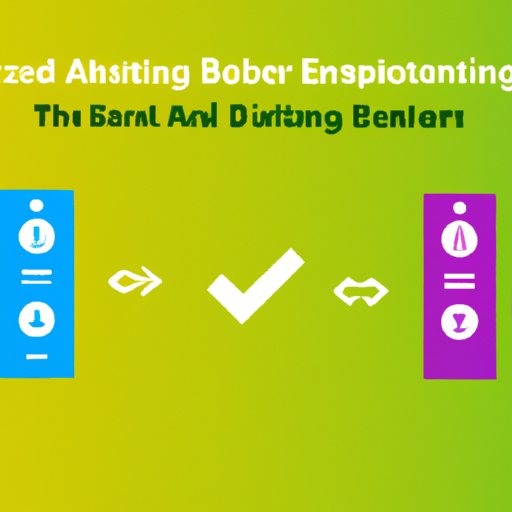Introduction
Data science is a field that involves using scientific methods, processes, algorithms, and systems to extract knowledge and insights from structured and unstructured data. As the use of data science becomes increasingly prevalent, so does the importance of A/B testing. But what is A/B testing in data science, and how can it help data scientists make better decisions? In this article, we will explore the basics of A/B testing in data science, as well as its benefits, challenges, and successful examples.
What is A/B Testing in Data Science?
A/B testing, also known as split testing or bucket testing, is a method of comparing two versions of a product, feature, or website against each other to determine which performs better. This type of testing is used to optimize various aspects of a product or feature, such as user experience, performance, and usability. In data science, A/B testing is used to compare different models or algorithms to find out which one works best. It is also used to test the efficacy of new features or changes to existing features.
Exploring the Benefits of A/B Testing for Data Scientists
A/B testing provides data scientists with a powerful tool for making informed decisions about their products or features. By running an A/B test, data scientists can quickly identify which version of the product or feature performs better and why. This helps them focus on improving the areas that are having the most impact on performance. Additionally, A/B tests can be run quickly and easily, allowing data scientists to quickly iterate on their ideas and get feedback in real time.
How to Use A/B Testing For Data-Driven Decision Making
When it comes to data-driven decision making, A/B testing is an invaluable tool. To get started with A/B testing, data scientists need to decide what to test and set up their experiment. This includes defining the goals of the test, setting up the control and variation groups, and deciding how to measure the results. Once the experiment is set up, data scientists can begin collecting data and analyzing the results.
A Comprehensive Guide to A/B Testing in Data Science
A/B testing in data science requires careful planning and thoughtful execution. To ensure that the test is effective, data scientists should consider the following steps:
- Define the goals of the test.
- Decide what to test and create a hypothesis.
- Set up the control and variation groups.
- Design the experiment and collect the data.
- Analyze the results and draw conclusions.
Understanding the Role of A/B Testing in Data Science
A/B testing plays a critical role in data science. By allowing data scientists to compare different models or algorithms, it helps them identify which ones work best and why. This allows them to focus their efforts on improving the areas that are having the most impact on performance. Additionally, A/B testing provides data scientists with valuable insights into user behavior, which can be used to optimize the user experience.
Analyzing the Impact of A/B Testing on Data Science Projects
A/B testing can have a significant impact on data science projects. Here are some of the key benefits of A/B testing for data science projects:
Benefits of A/B Testing for Data Science Projects
- A/B testing helps data scientists quickly identify which models or algorithms perform best.
- It allows data scientists to focus on improving the areas that are having the most impact on performance.
- It provides data scientists with valuable insights into user behavior.
- It can be used to optimize the user experience.
Challenges of A/B Testing for Data Science Projects
- A/B testing requires careful planning and execution.
- It can be difficult to isolate the variables being tested.
- It can be challenging to draw meaningful conclusions from the data.
Examples of Successful A/B Tests in Data Science
A/B testing has been used successfully in many data science projects. For example, Google used A/B testing to improve its search engine results by testing different algorithms and ranking models. Amazon used A/B testing to optimize its website design and layout, resulting in improved user engagement and higher sales. Airbnb used A/B testing to optimize its pricing algorithm, resulting in increased revenue.
Conclusion
A/B testing is an invaluable tool for data scientists. It allows them to quickly identify which models or algorithms work best and why, as well as gain valuable insights into user behavior. While A/B testing requires careful planning and execution, the benefits far outweigh the challenges. From Google to Amazon to Airbnb, many organizations have seen success with A/B testing in data science.
Summary of A/B Testing in Data Science
A/B testing is a method of comparing two versions of a product, feature, or website against each other to determine which performs better. It is used in data science to compare different models or algorithms and optimize various aspects of a product or feature. A/B testing can provide data scientists with valuable insights into user behavior and help them make informed decisions about their products or features.
Further Resources for Learning About A/B Testing in Data Science
For more information on A/B testing in data science, check out the following resources:
- Optimizely: A/B Testing for Data Science
- HubSpot: A/B Testing and Data Science
-
(Note: Is this article not meeting your expectations? Do you have knowledge or insights to share? Unlock new opportunities and expand your reach by joining our authors team. Click Registration to join us and share your expertise with our readers.)
